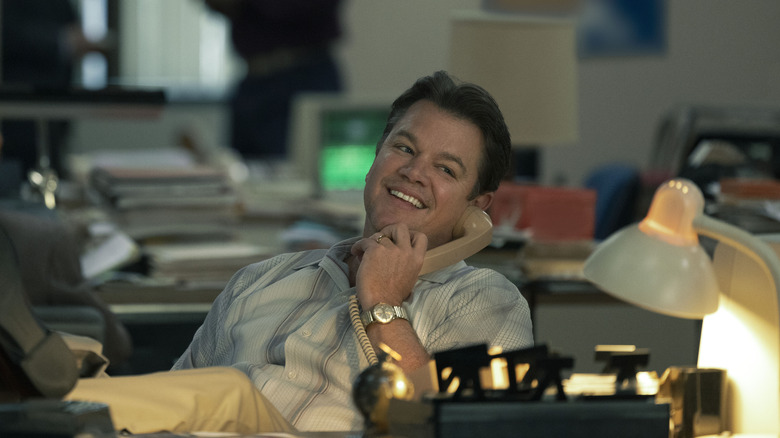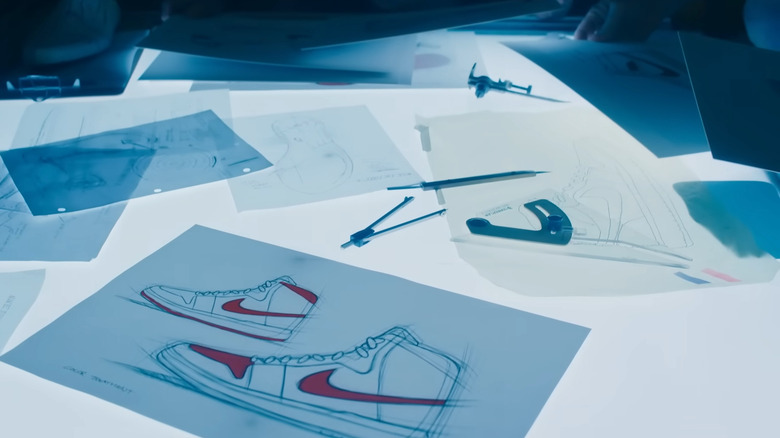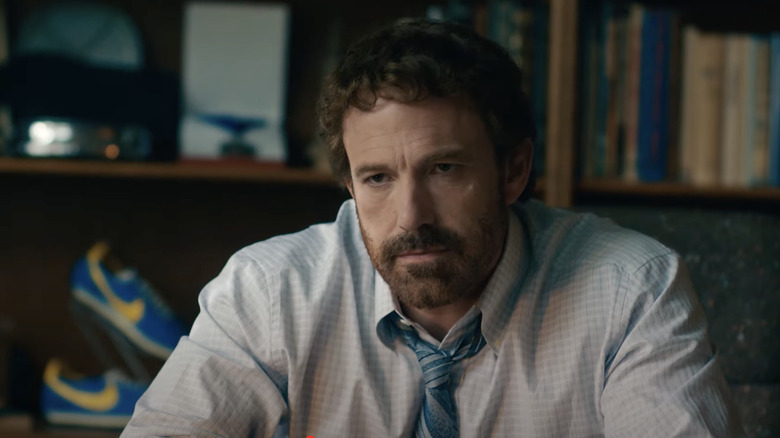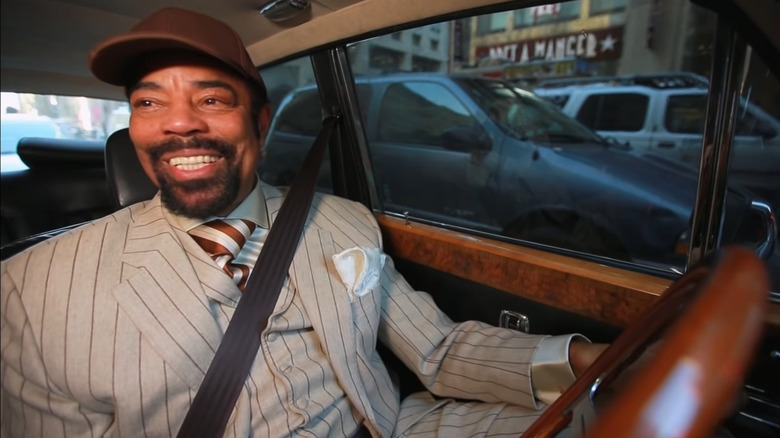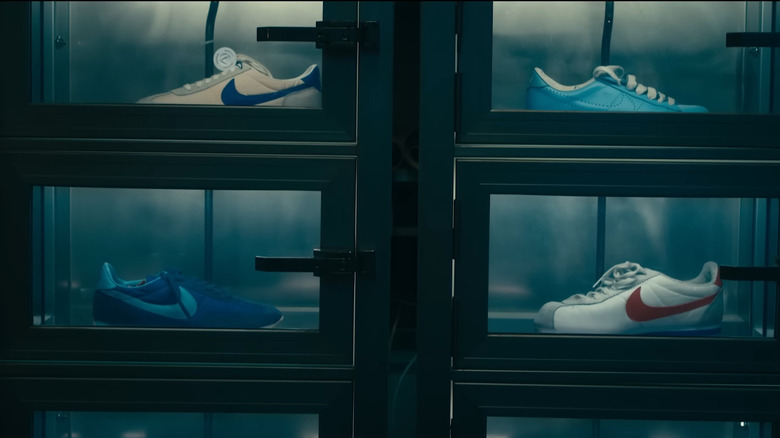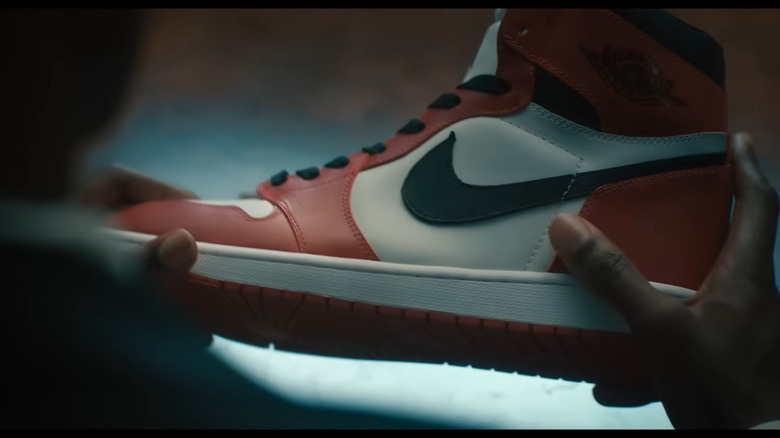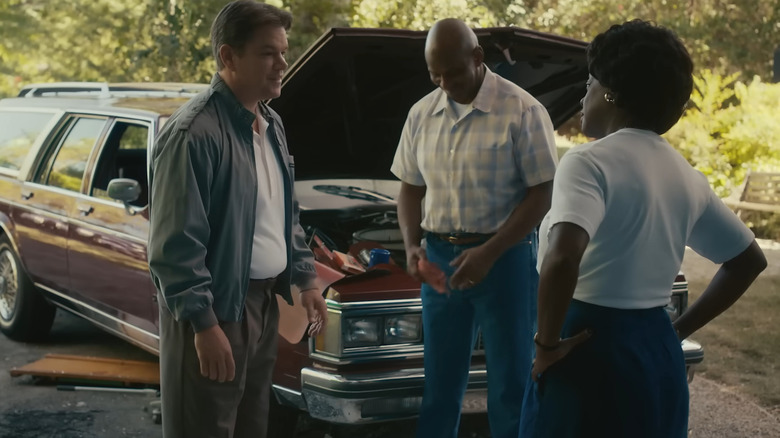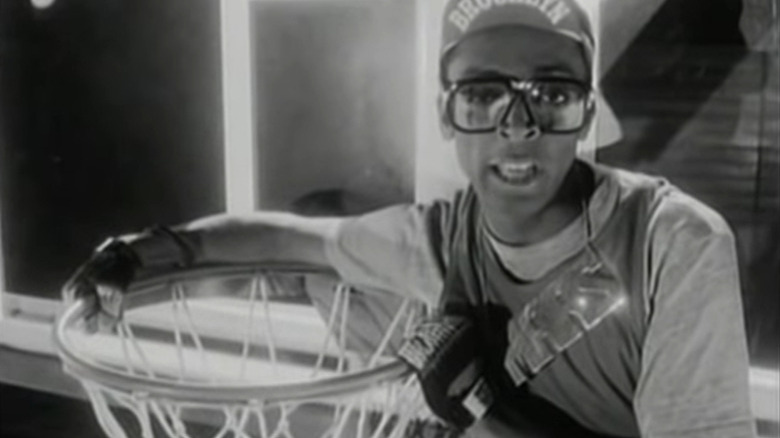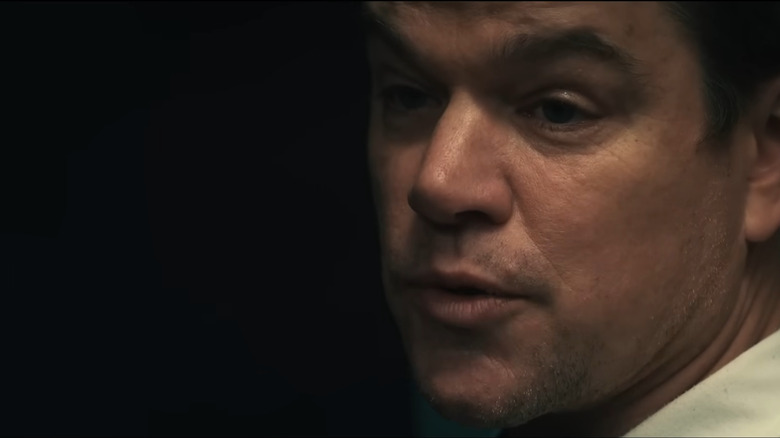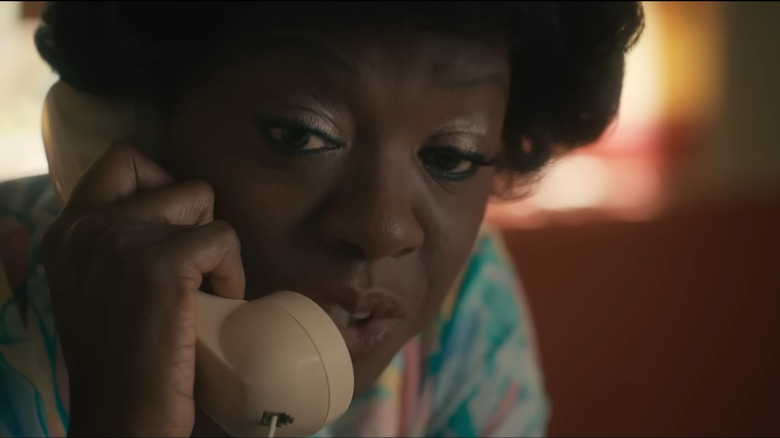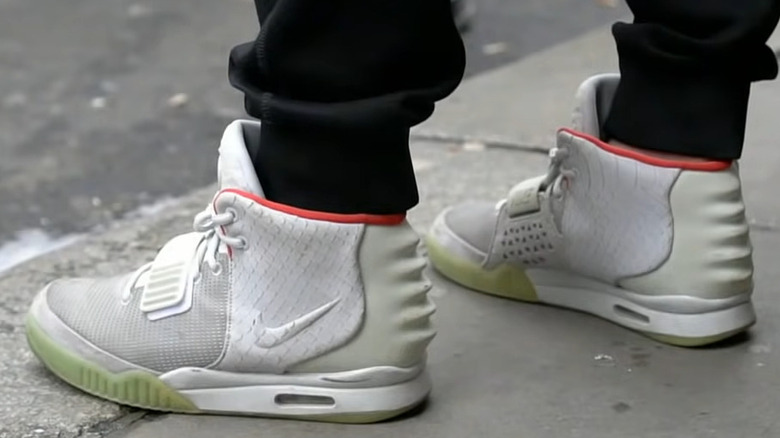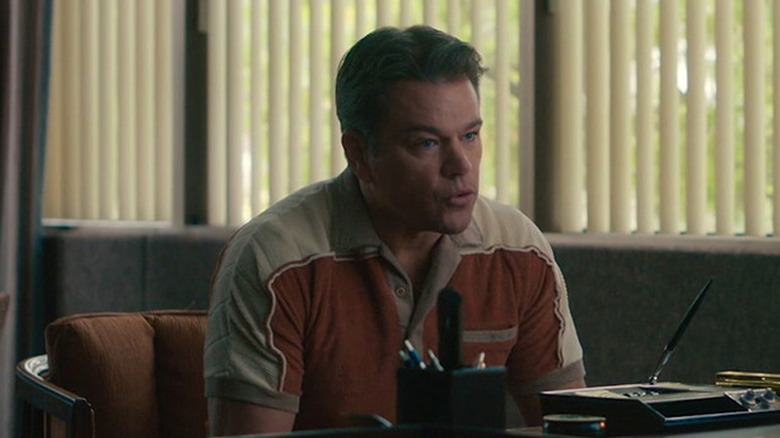Everything Air Gets Wrong (Or Doesn't Tell You) About The True Story
Contains spoilers for "Air"
Who would've thought the story regarding the creation of a shoe could be so compelling and well-acted? "Air," directed by Ben Affleck and written by Alex Convery, is the dramatized version of the creation of Nike's flagship shoe, the Air Jordan. The film's marketing notes that it is inspired by true events, which is mostly accurate, but does require some analysis.
To the film's credit, much like "Argo," the film does recount the events somewhat faithfully, but doesn't shy away from taking severely dramatic liberties. While truth can indeed be stranger than fiction, it's not uncommon for Hollywood to bend the truth a little or, in many cases, a lot.
If you want a non-dramatized version of the story, check out the documentary, "One Man and His Shoes." Directed by Yemi Bamiro, the documentary actually features testimony from many of the key people involved with Air Jordans. With all that in mind, lace up your Jordans, because this is everything that "Air" gets wrong about the true story.
They didn't anticipate Air Jordans being banned by the NBA
Partway through "Air" we get to see a dramatized version of the actual design of the original Air Jordan prototype. What is shown is a fairly true-to-life depiction of the development process, spiced up with some comedic banter with Peter Moore, played by Matthew Maher. Amidst his exchanges with Vaccaro and others, he notes that a majority of the Air Jordan must be white, but why, you may ask?
This is due to the fact that the National Basketball Association does in fact have a strict rule about their players' shoes being 51% white. They even note that if this rule is not adhered to, the player could be fined for every single game that the shoe was worn. However, here is where we must delineate between Hollywood embellishment and the actual truth. Per the testimonies featured in the documentary "One Man and His Shoes," they simply designed the shoe based on the color scheme of the Chicago Bulls.
However, in the film, they actually predict the potential repercussions from the league and note how that could actually work to their advantage, marketing-wise. In real life, they didn't realize this issue in advance, only becoming aware of it when the NBA expressed concerns, forcing them to rework their marketing strategy. This proved to be a success and Rob Stasser even wrote David Stern, the former commissioner of the NBA, a thank-you note for the ban. In a hilarious twist, Stern replied back and said, "Can you send me the banned shoes for my son, he thinks I'm a jerk."
The characters' appearances
Most of the characters in "Air" only loosely resemble the actual real-life people that they are based on. This is par for the course with just about any film that's inspired by a true story, but it's still worth bringing up. Despite both giving quality performances, neither Matt Damon nor Ben Affleck look particularly like Sonny Vaccaro or Phil Knight. For one thing, the real Phil Knight was a natural redhead, whereas Affleck has dark brown hair, resulting in the wig he wears in the movie. Funnily enough, the detail of Knight having his bare feet on his desk is actually true, corroborated by an archival image shown in the end credits.
Additionally, even on his worst day, Matt Damon will always look like a movie star, no matter how much weight he gains for a role. The real Sonny Vaccaro, while far from an unattractive person, doesn't exactly have a mug worthy of a glossy movie poster. However, as we mentioned this is simply the standard for any cinematic adaptation of real-life events, it does mark the main distinction of what you can get from a narrative fiction film versus a documentary.
No mention of Walter Clyde Frazier Jr.
One of the most admirable aspects of "Air" is, despite its many tweaks and alterations, how effectively it situates you in the time period. The film even begins with a lovely montage sequence rife with various 1980s staples such as pro wrestling, political ads, and various nostalgic commercials. It also does a great job of establishing who were the biggest names in basketball before and during the '80s. This includes the likes of Larry Bird of the Boston Celtics and Magic Johnson of the Los Angeles Lakers. It's worth noting however that one player who doesn't receive a nod or a mention is Walter "Clyde" Frazier Jr.
Clyde, a player for the New York Knicks and the Cleveland Cavaliers, is hailed by many as the prototype for the cool, aspirational basketball player. In photos and advertisements, he always had very stylish clothes, shoes, and various fancy cars. In "One Man and His Shoes" they mention this very early on, explaining how he basically created the model that Air Jordans followed. Air Jordans were built predominantly off of Michael Jordan's public persona, meaning that young kids and teens would want to emulate him. Still, Clyde isn't name-dropped during the film which, considering his influence on the game and the marketing of athletes, feels like a glaring omission.
How much was a typical shoe contract at the time?
Money makes the world go round, and it certainly plays a big part in the story of the Air Jordans' creation. One of the more significant points of conflict in the film's first half is in regard to Nike's allotted budget for their new basketball shoes. With only $250,000 to work with, they originally intend to pass on Jordan and sign three other players to maximize their budget. Remember, Nike wasn't doing well during the early '80s, so it makes sense that they'd want to play it safe. It was Sonny Vaccaro who championed the idea of taking the entire budget and putting it behind one single player in Michael Jordan, gambling on his potential star power.
However, one thing that the film doesn't clarify is just how much the typical athlete's shoe contract was during that time. Per testimonies from "One Man and His Shoes," the average contact at the time was usually capped at around $9,000 to $10,000. An exception to this — which the documentary also mentions — was Kareem Abdul-Jabbar of the Milwaukee Bucks and the Los Angeles Lakers whose contract was around $100,000. That added detail might've added a bit more context as to why the conversations regarding the budget of Air Jordans were so tense.
Michael thought the design was satanic at first
One aspect of the film that some viewers might find a bit odd is how, despite being featured in the film, we never actually see Michael Jordan's face. Per a Hollywood Reporter interview with Ben Affleck, he noted that "It was a deliberate choice. I thought he was too majestic to have anyone impersonate him and — as I told him — 'You're too old to play the part.'" Despite this, the film still manages to include Michael in one of the most pivotal scenes: The first meeting between him and the Nike team. With his mother and father in tow, they sit down to discuss the proposed deal and why Michael should consider working with Nike over Converse or Adidas.
Michael examines the prototype version of the Air Jordan and, despite very little dialogue from him, he seems impressed with it. However, likely due to time constraints, the filmmakers opted to leave out a detail that might've made a funny gag. As mentioned in "One Man and His Shoes," due to his religious upbringing, Jordan thought the Air Jordans' red color scheme looked satanic upon first glance. While not a totally necessary detail to include, it might've added an extra bit of character to this fictitious version of Michael Jordan.
The Jordans weren't that hard to convince
The major crux of the film's first half is Sonny Vaccaro continually pushing to put Nike's entire basketball budget behind Michael Jordan. After seeing him at an early collegiate game, Sonny always had Jordan at the back of his mind, seeing the greatness he was capable of. This is played up a bit more heavily in the film, but it isn't that far off from how Vaccaro really felt in real life. His uncompromising commitment to recruiting Jordan led to the part of the film you'd swear was fictional: Sonny showing up at Michael Jordan's house unannounced to speak to his parents.
What follows is a wonderfully acted back-and-forth conversation between Sonny and Michael's mother, Deloris Jordan (Viola Davis) outside in the backyard. She makes it very clear that Michael simply doesn't like Nike and has very little interest in signing on with them. Sonny then predicts how their impending meetings with Adidas and Converse will go, asking Deloris to think it over.
This makes for great drama, but it's a bit of a far cry from how it actually went down. Upon giving Michael their pitch, he was instantly impressed by it, noting that he appreciated its boldness. As mentioned in "One Man and His Shoes," Delores confirmed with Vaccaro and his team Michael's interest, saying, "Don't worry about it, Michael will be wearing Nike."
No mention of Spike Lee's Nike commercials
This is one of the more glaring omissions from the film, as the success of the Air Jordans were boosted by another man, Spike Lee. "One Man and His Shoes" makes a point of mentioning how, after its launch, Air Jordans really took on a life of their own, even with Nike itself. In their first year on the market, Air Jordans made a whopping $125 million dollars, far exceeding anyone's expectations.
So when the Air Jordan 3 was en route for release in the late '90s, Nike launched an interesting advertising campaign. Air Jordans had been used in a prominent gag in Spike Lee's debut film, "She's Gotta Have It," adding to their ubiquity within Black culture. So, to capitalize on this, Nike and Wieden+Kennedy, an advertising agency, signed Lee on to produce commercials with his Mars Blackmon character. The ads saw Jordan interacting with Blackmon, hyping up both the shoes and Jordan's clout as a major athlete. Needless to say, the ads were a hit across the board and made Air Jordans even more of a household name than they already were. Today, if you ask someone about Air Jordans, there's a very good chance they'll mention these commercials.
Sonny didn't really give a rousing speech
Every film needs a climax in some form or fashion, even if the true story it's telling doesn't necessarily have one. Funny enough, this isn't even the first time a Ben Affleck-helmed adaptation of a true story has done something like this.
If you think back on "Argo" for a moment, the first thing that comes to mind will likely be the tense final 15 minutes showing the escape of the diplomat posing as a film crew. The film portrays their escape as a nailbiter with the Iranians even chasing their plane as it takes off. This stands in stark contrast to real life, where aside from a couple of minor risks, the plan went off without a hitch.
In "Air," the film reaches its climax during Nike's sit-down meeting with Michael and his parents in Beaverton. After some awkward introductions, they proceed to show Michael a sizzle reel of sorts, much like in real life. However, it's here that Sonny goes off script and decides to be completely honest with Michael, delivering a dramatic speech about his potential legacy. We're even shown future clips and images of Michael, painting a clear picture of the pop culture icon he'd become. This is far more dramatic than the real-life meeting, wherein Michael was impressed with their reel and the overall speech, signing on shortly after. And obviously, although Sonny foresaw the promising career Jordan went on to have, his speech didn't really include the ultra-specific details of the athlete's ups and downs.
Things weren't as dramatic as presented
We've touched on this a little bit already, but it's worth noting just how much "Air" inflates its own drama. Now to be clear, we aren't implying that Nike wasn't dealing with particularly difficult circumstances at the time. Not only were their sales significantly down, but they weren't respected within the world of athletic wear, especially when compared to the likes of Adidas and Converse. So it made sense that a gamble like Air Jordans would result in a fair amount of frustration and some harsh conversations.
However, business struggles in real life, even at their most intense, are a far cry from how they are often portrayed in cinema. In "One Man and His Shoes," Sonny Vaccaro definitely notes the stressful ups and downs en route to the deal being solidified. Never once, though, does he mention a dramatic moment where he looks around the Nike office at various employees, worried that he was gambling with their careers as well. There are other instances of this as well, especially when it comes to Sonny's interactions with Dolores Jordan. As charming as their scenes are, the dialogue is significantly more snappy and cinematic than it likely was in real life.
No mention of how Air Jordans have become a staple of Black culture
Representing multiple points of view at once is important, especially when covering something like Air Jordans. One thing the movie does not fall short of explaining was just how successful the shoes were, bringing in over $100 million dollars in their first year alone. The film itself also shows, albeit in a dramatized fashion, just how arduous the production process and negotiations around the shoes were.
However, one thing that "Air" doesn't quite hit the mark with is showcasing just how big a part of Black culture Air Jordans became. We already mentioned the lack of a mention for the Spike Lee-helmed Air Jordan III commercials that capitalized on the success of "She's Gotta Have It." But beyond that, just a bit more content that speaks to the legacy and ubiquity of the shoes would have been appreciated. A showcase in regards to the widespread popularity of Air Jordans could've made for a great montage sequence. It feels as though the film missed an opportunity to show another perspective beyond just the employees at Nike working behind the scenes.
Sonny Vaccaro was fired from Nike in 1991
One thing that many films that are based on true stories must often contend with is the harsh nature of reality. What we mean is, oftentimes a film will pick a point to end things right before a less-than-ideal real-life development. For example, "Ed Wood" wrapped up with Ed (Johnny Depp) feeling like a success and getting married, as opposed to showcasing the sad, alcohol-filled final years of his career.
In this instance, "Air" ends with the Air Jordans becoming a success and showing a montage of where everyone is today. We're given a brief blurb regarding Sonny Vaccaro as well, but what the film neglects to mention is how his time at Nike ended. During an interview with the Los Angeles Times, Vaccaro revealed that by the early 1990s had come around, his relationship with Nike had changed.
Nike was going one way and Vaccaro was going another, with the latter seeing the writing on the wall during a tense meeting with Phil Knight. Vaccaro was quoted as saying, "I feel like a gunslinger in the Old West ... Now, those townspeople no longer want the gunslinger around because he just doesn't seem to fit their new image." Definitely an unfortunate turn of events and a detail that, if included in "Air," could've tainted the film's happy ending.
